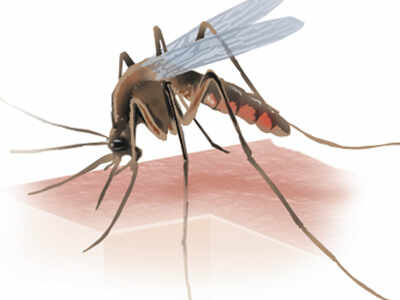
KOLKATA: A set of norms for treating dengue patients — laid down by the Kolkata Municipal Corporation (KMC) and being enforced by the state health department — has evoked a mixed response from private hospitals and doctors. While a part of the protocol prescribed according to WHO guidelines has been accepted, a recommendation on transfusing platelets has led to concerns among a section of the private healthcare system. While the KMC announced its decision on Friday, a four-member health department team has already started inspecting private hospitals.
The civic authorities have sought all private hospitals to stick to the Elisa test to determine dengue and reject the NS1 rapid test which is believed to be inaccurate. They have also asked hospitals to reserve at least 10 beds for dengue patients and not to refuse admission to any. But it is the health department’s advisory on platelet transfusion that has led to a divided opinion. Platelet should drop to 10,000 before transfusion is considered, it has been suggested. “There can’t be any standard instruction on platelet use since it will depend on the condition of individual patients. If the drop is very sharp and the patient is bleeding in vital areas, then you can’t wait for platelet to come down to 10,000,” said a consultant of a private hospital.
A health department team visited Ruby General Hospital earlier this week to check its dengue-preparedness. “We have been asked to stick to Elisa test which we will follow. Our clinicians were asked to wait for platelet to drop to 10,000 before transfusion is done. We hope to manage dengue cases efficiently this year,” said Subhashish Datta of Ruby.
The laying down of WHO norms was a positive move and will lead to uniformity in treatment, felt Medica Superspecialty Hospital intensivist Aviral Roy. “While it is best to follow WHO protocol, platelet transfusion should be left at the discretion of the doctor,” said Roy.
Apollo Gleneagles Hospital consultant Shyamasish Bandopadhyay, though, felt that platelet infusion can wait till count drops to 10,000. “Even though it is prudent to start infusion at 20,000, we can wait till it reads 10,000. The count is the only indicator that tells us if a dengue patient needs infusion,” he said.
Union health ministry guidelines, on the other hand, specify that rather than the platelet count, bleeding should guide infusion. “Once a dengue patient starts bleeding, transfusion becomes inevitable. But it is unlikely to happen unless the platelet count has dropped to less than 20,000. Both health ministry norms and our protocol say that transfusion should wait till then but bleeding should be monitored to arrive at a final decsion,” said KK Aggarwal, ex-secretary-general of Indian Medical Association.
“In terms of specificity and sensitivity, the Elisa is a more reliable test. But an NS1 rapid test is important for despite the chances of being ‘false positive’, it does ring an alarm bell that cautions the patient and doctors,” said Debashish Saha, consultant at AMRI Hospital, Salt Lake.
The state team has also prescribed a fluid management protocol to Ruby doctors. It could be a key to saving lives of dengue patients, felt senior medics.
The civic authorities have sought all private hospitals to stick to the Elisa test to determine dengue and reject the NS1 rapid test which is believed to be inaccurate. They have also asked hospitals to reserve at least 10 beds for dengue patients and not to refuse admission to any. But it is the health department’s advisory on platelet transfusion that has led to a divided opinion. Platelet should drop to 10,000 before transfusion is considered, it has been suggested. “There can’t be any standard instruction on platelet use since it will depend on the condition of individual patients. If the drop is very sharp and the patient is bleeding in vital areas, then you can’t wait for platelet to come down to 10,000,” said a consultant of a private hospital.
A health department team visited Ruby General Hospital earlier this week to check its dengue-preparedness. “We have been asked to stick to Elisa test which we will follow. Our clinicians were asked to wait for platelet to drop to 10,000 before transfusion is done. We hope to manage dengue cases efficiently this year,” said Subhashish Datta of Ruby.
The laying down of WHO norms was a positive move and will lead to uniformity in treatment, felt Medica Superspecialty Hospital intensivist Aviral Roy. “While it is best to follow WHO protocol, platelet transfusion should be left at the discretion of the doctor,” said Roy.
Apollo Gleneagles Hospital consultant Shyamasish Bandopadhyay, though, felt that platelet infusion can wait till count drops to 10,000. “Even though it is prudent to start infusion at 20,000, we can wait till it reads 10,000. The count is the only indicator that tells us if a dengue patient needs infusion,” he said.
Union health ministry guidelines, on the other hand, specify that rather than the platelet count, bleeding should guide infusion. “Once a dengue patient starts bleeding, transfusion becomes inevitable. But it is unlikely to happen unless the platelet count has dropped to less than 20,000. Both health ministry norms and our protocol say that transfusion should wait till then but bleeding should be monitored to arrive at a final decsion,” said KK Aggarwal, ex-secretary-general of Indian Medical Association.
“In terms of specificity and sensitivity, the Elisa is a more reliable test. But an NS1 rapid test is important for despite the chances of being ‘false positive’, it does ring an alarm bell that cautions the patient and doctors,” said Debashish Saha, consultant at AMRI Hospital, Salt Lake.
The state team has also prescribed a fluid management protocol to Ruby doctors. It could be a key to saving lives of dengue patients, felt senior medics.
World Cup 2019
Trending Topics
LATEST VIDEOS
City
 Delhi: Speeding car kills CRPF man, teenaged son of a Noida-based businessman held
Delhi: Speeding car kills CRPF man, teenaged son of a Noida-based businessman held  Congress leader Yashomati Thakur creates ruckus, after being stopped from meeting Karnataka MLA in hospital
Congress leader Yashomati Thakur creates ruckus, after being stopped from meeting Karnataka MLA in hospital  Heavy rains lead to flood-like situation in Kerala, 3 killed
Heavy rains lead to flood-like situation in Kerala, 3 killed  Major road mishap on Pune-Solapur highway, 9 people killed on spot
Major road mishap on Pune-Solapur highway, 9 people killed on spot
More from TOI
Navbharat Times
Featured Today in Travel
Quick Links
Lok Sabha Election Schedule 2019Lok Sabha Election NewsDelhi Capitals teamMI team 2019Rajasthan Royals 2019RCB team 2019Maharashtra Lok Sabha ConstituenciesBJP Candidate ListBJP List 2019 TamilnaduShiv Sena List 2019AP BJP List 2019Mamata BanerjeeBJP List 2019 MaharashtraPriyanka GandhiBJP List 2019 KarnatakaAMMK Candidate List 2019BJP List 2019 WBLok Sabha Elections in Tamil NaduBSP List 2019 UPNews in TamilLok Sabha Poll 2019Satta Matka 2018PM ModiMahagathbandhanNagpur BJP Candidate ListChandrababu NaiduTamil Nadu ElectionsUrmila MatondkarNews in TeluguMadras High CourtTejashwi YadavArvind KejriwalTejasvi SuryaPawan KalyanArvind KejriwalYogi AdityanathJaya PradaSatta King 2019Srinagar encounter
Get the app





